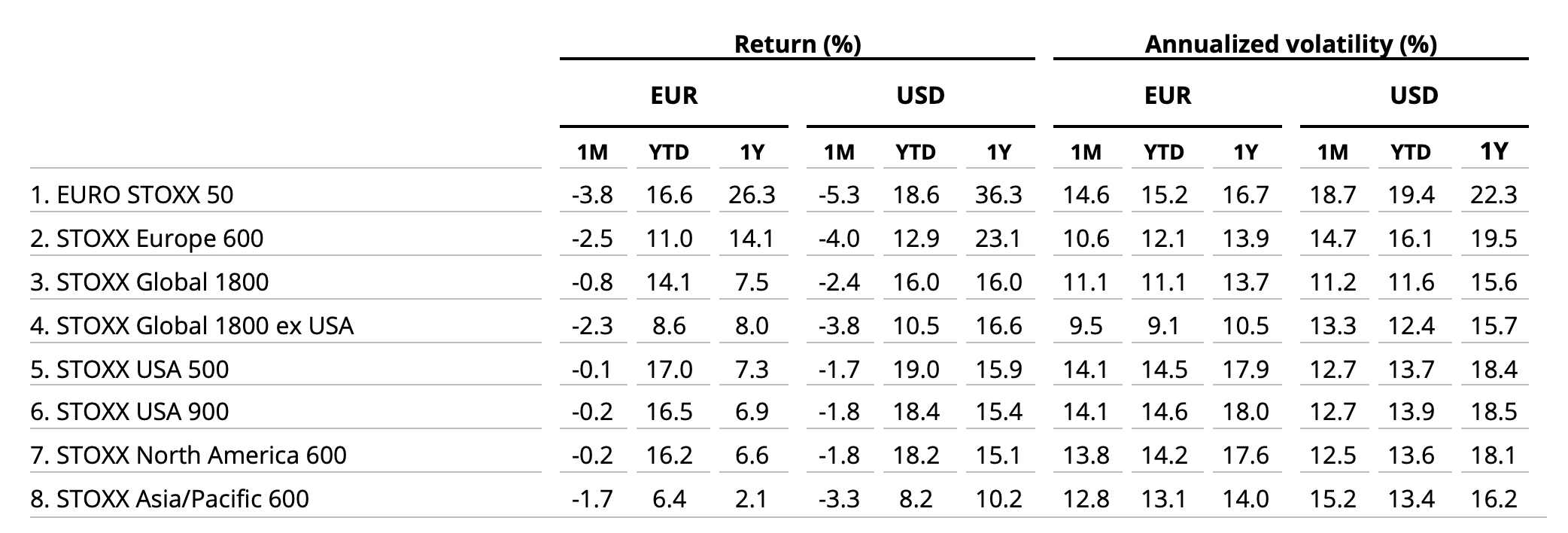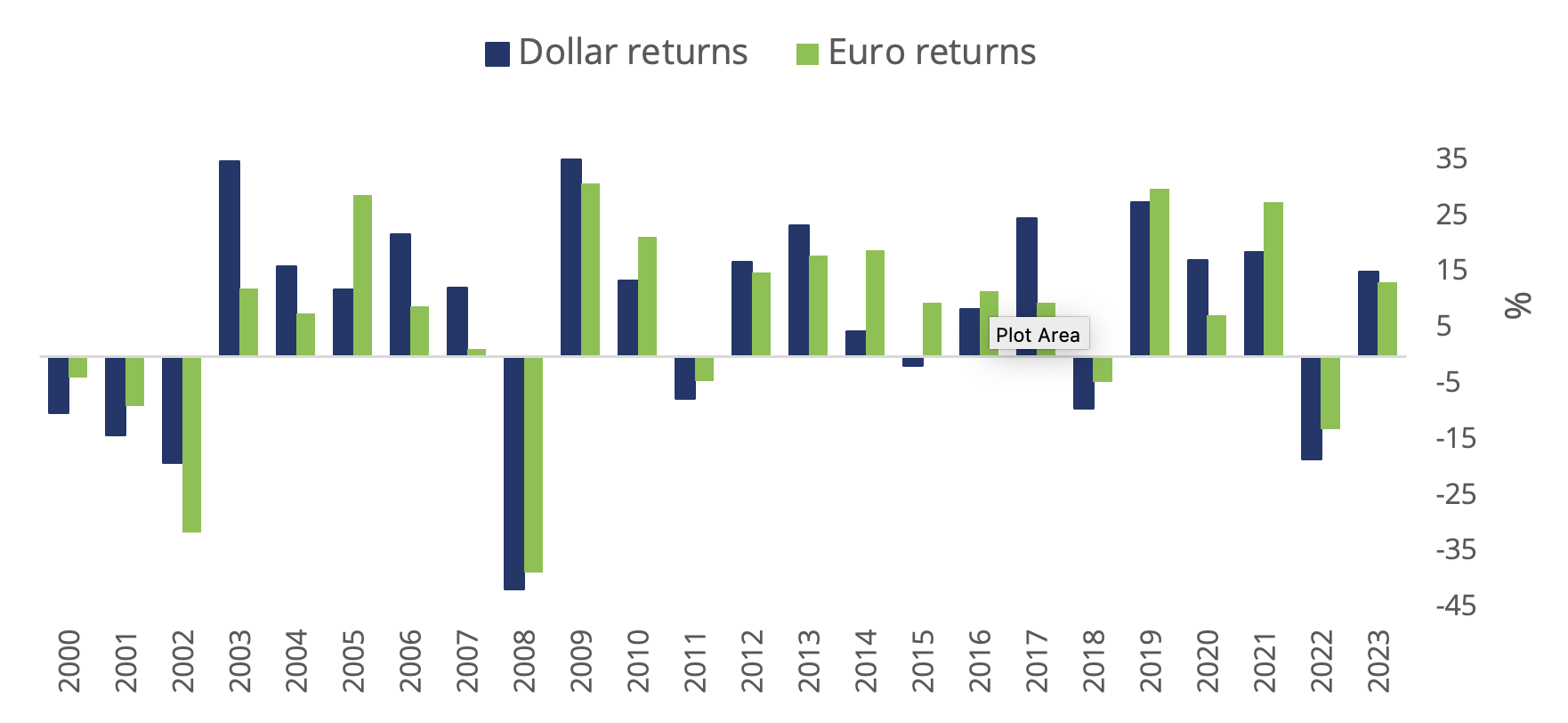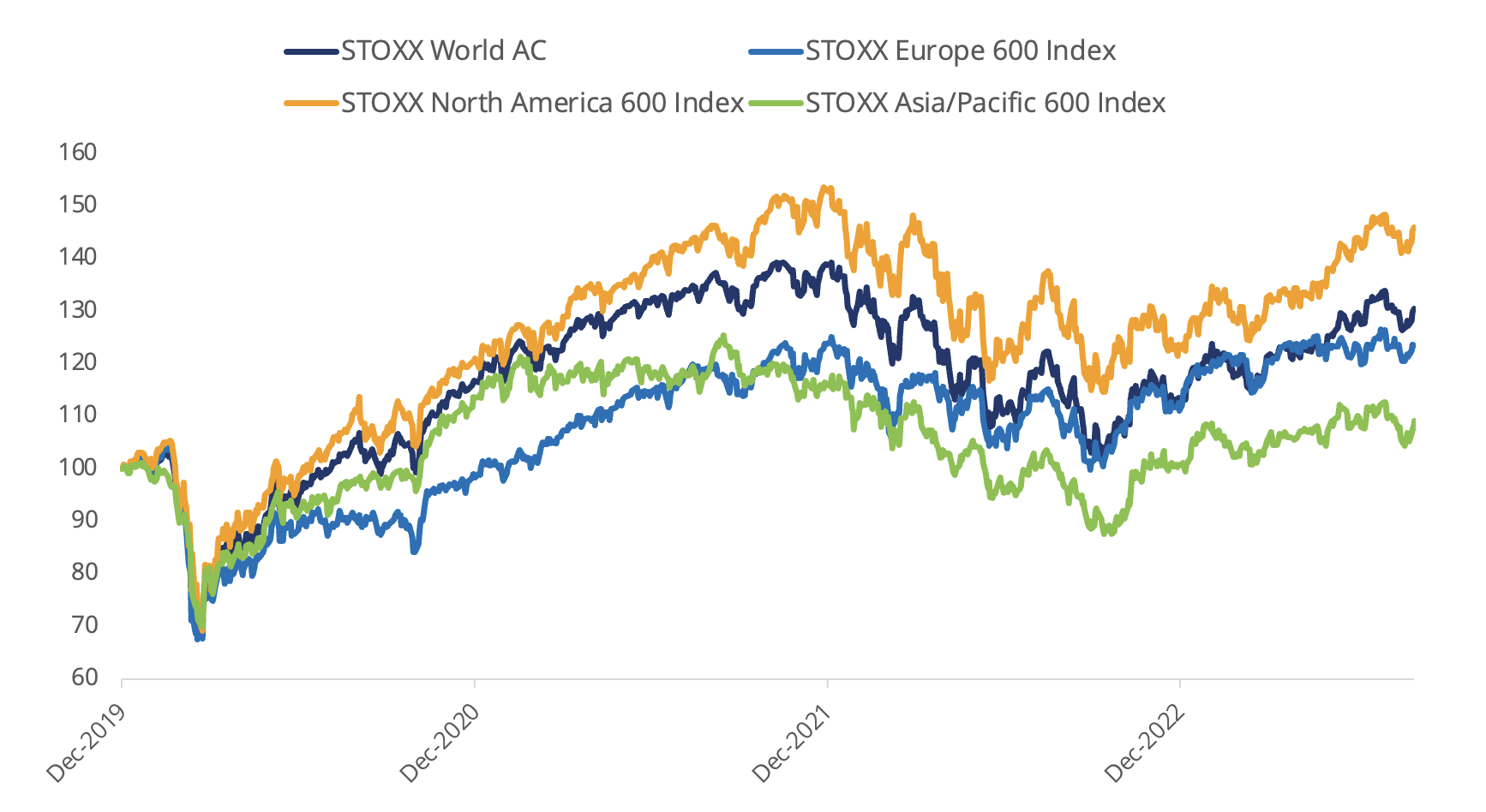
Stocks fell in August amid expectations that US interest rates may stay high for a long period, and following softening economic data in Europe and China.
The STOXX® Global 1800 index shed 2.4% last month when measured in dollars and including dividends,[1] reducing its gain in 2023 to 16%. The benchmark slid 17.9% in 2022, its worst year since 2008, as central banks pressed ahead with higher rates to fight runaway inflation. The index fell 0.8% in euros in August, the first retreat in eight months, after the greenback rose 1.6% against the common currency. The STOXX® World AC index fell 2.7% in dollars.
The Eurozone’s EURO STOXX 50® dropped 3.8% in euros in the month on a total-return basis, while the pan-European STOXX® Europe 600 declined 2.5%,[2] both falling from record highs. The STOXX® North America 600 dropped 1.8% in dollars, while the STOXX® USA 500 fell 1.7%. The STOXX® Asia/Pacific 600 lost 3.3% in dollars. The STOXX® Developed World shed 2.4%, and the STOXX® Emerging Markets slid 5.6%, its worst performance since June 2022.
Figure 1: STOXX Benchmark indices’ August risk and return

Figure 2: STOXX Equity World indices’ August risk and return

Germany’s DAX® fell 3% in the month. MDAX®, which gauges the performance of German mid-caps, retreated 3.5%.
| For a complete review of all indices’ performance last month, visit our August index newsletter |
Strong US, weak rest of the world
Releases in August showed the US jobs market continues to expand steadily and wages are rising, giving the Federal Reserve room to keep interest rates high to combat inflation. In the Eurozone, purchasing managers’ indices pointed to a weakening economy and persistently high inflation.[3] Concerns about slowing economic growth and a crisis in the domestic real-estate sector drove the STOXX® China A 900 index down 8.1% in August, its worst month in ten.[4]
Figure 3: Total annual % returns for STOXX World AC index

Figure 4: Select STOXX benchmarks’ returns since Jan. 1, 2020

Volatility
The EURO STOXX 50® Volatility (VSTOXX®), which tracks EURO STOXX 50 options prices, was little changed over the month. The index fell to 16.1 at the end of last month from 16.2 in July. A higher VSTOXX reading suggests investors are paying up for puts that offer insurance against stock price drops. The VDAX-New®, which measures volatility in German equities, dropped to 14.5 from 15.6 in July.
Banks lead losses
Seventeen of 20 Supersectors in the STOXX Global 1800 had negative returns in August, led by a 6.6% retreat for the STOXX® Global 1800 Banks index.
All 25 developed markets tracked by STOXX fell in the month when measured in dollars, except for Denmark. All but three of 20 national developing markets tracked by STOXX declined.
Factor investing
On a global basis, Value was the worst-performing factor style in August after leading for two consecutive months, according to the STOXX Factor indices. Momentum showed the smallest losses.
Figure 5: STOXX Factor (Global) indices’ August risk and return characteristics

Climate benchmarks
Among climate benchmarks, the STOXX® Global 1800 Paris-Aligned Benchmark (PAB) (-2.1%)[5] and the STOXX® Global 1800 Climate Transition Benchmark (CTB) (-2.2%) outperformed their benchmark slightly in the month. The PAB and CTB indices follow the requirements outlined by the European Commission’s climate benchmarks regulation.
The STOXX® Willis Towers Watson World Climate Transition Index lost 2.4%. The STOXX Willis Towers Watson Climate Transition Indices (CTIs) employ a unique Climate Transition Value at Risk (CTVaR) methodology that quantifies the anticipated impact of an economic transition on equity valuations. The CTIs look beyond carbon emissions and make a forward-looking, bottom-up evaluation of asset repricing risks in a decarbonization pathway.
Among the STOXX Low Carbon indices, the EURO STOXX 50® Low Carbon (-4.1%) underperformed the EURO STOXX 50 by 31 basis points in August. Elsewhere, the STOXX® Global Climate Change Leaders (-1.1%), which selects corporate leaders that are publicly committed to reducing their carbon footprint, outperformed the STOXX Global 1800 by 134 basis points.
Sustainability indices
The STOXX® Global 1800 ESG-X index slid 2.4% in the month. The STOXX® ESG-X indices are versions of traditional, market-capitalization-weighted benchmarks that observe standard responsible exclusions.
Within indices that combine exclusions and ESG best-in-class integration, the EURO STOXX 50® ESG index fell 2.2% in August, outperforming its benchmark by 163 basis points. Germany’s DAX® 50 ESG index (-3.6%), which excludes companies involved in controversial activities and integrates ESG scoring into stock selection, underperformed the benchmark DAX.
Among other STOXX sustainability families, the STOXX® Global 1800 ESG Broad Market fell 2.4% in the month. The STOXX ESG Broad Market indices apply a set of compliance, product involvement and ESG performance exclusionary screens on a starting benchmark universe until only the 80% top ESG-rated constituents remain.
The STOXX® Global 1800 ESG Target lost 2.5%, the EURO STOXX® ESG Target fell 2.6% and the DAX® ESG Target dropped 2.8%. The STOXX and DAX ESG Target indices seek to significantly improve the benchmark portfolio’s ESG profile while mirroring its returns as closely as possible. Through a series of constraints, the indices implement an optimization process to maximize the overall ESG score of the portfolio while limiting the tracking error to the benchmark.
The STOXX® Global 1800 SRI retreated 2.2%. The STOXX SRI indices apply a rigorous set of carbon emission intensity, compliance and involvement screens, and track the best ESG performers in each industry group within a selection of STOXX benchmarks.
Finally, the DAX® ESG Screened fell 3.5% in the month. The index reflects the composition of the DAX benchmark minus companies that fail to pass norms-based and controversial weapons screenings, meet minimum ESG ratings or are involved in certain business activities considered undesirable from a responsible investing perspective.
Thematic indices
Among 33 STOXX® Thematic indices, 27 underperformed the benchmark STOXX Global 1800 last month.
Most dividend strategies also underperformed. The STOXX® Global Maximum Dividend 40 (-4.8%) selects only the highest-dividend-yielding stocks. The STOXX® Global Select Dividend 100 (-4.2%) tracks companies with sizeable dividends but also applies a quality filter such as a history of stable payments.
Minimum variance
Minimum variance strategies had mixed relative performances last month, with those in Europe doing best. The STOXX® Global 1800 Minimum Variance fell 1.1% and the STOXX® Global 1800 Minimum Variance Unconstrained lost 2.9%.
The STOXX Minimum Variance Indices come in two versions. A constrained version has similar exposure to its market-capitalization-weighted benchmark but with lower risk. The unconstrained version, on the other hand, has more freedom to fulfill its minimum variance mandate within the same universe of stocks.
[1] All results are total returns before taxes unless specified.
[2] Throughout the article, all European indices are quoted in euros, while global, North America, US, Japan and Asia/Pacific indices are in dollars.
[3] See ING, ‘Eurozone PMI paints worrisome growth picture,’ Aug. 23, 2023.
[4] For more on this, see FT, ‘Foreign investors sell China shares at record pace in August,’ Aug. 31, 2023.
[5] Figures in parentheses show last month’s gross returns.



